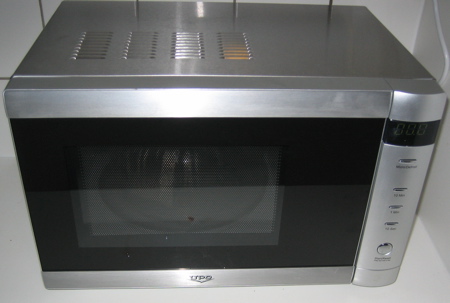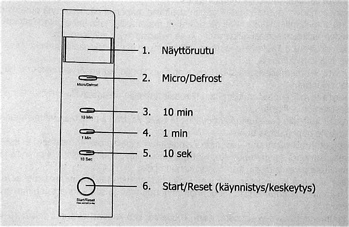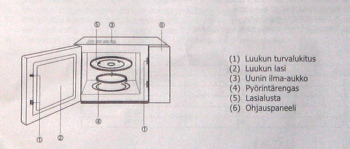Sunday evening. It is +3 ºC and raining: a fitting weather for the last soccer session of the summer. So when I come home, I am wet, cold, and starving.
I strip out of my dripping clothes and step to the kitchen. I don’t turn the lights on since I haven’t installed curtains on the kitchen window, and I don’t want old ladies oogling at me in my underwear. I take a bowl of noodle soup from the fridge and put it in my microwave. I press the one-minute-button twice, see “200” – meaning two minutes – on the display, and press the start button. I then go to my bedroom and turn the TV on, just in time to see a dancing dog in Finland’s Got Talent.
Fifteen minutes later I remember my soup, and go to the kitchen.
The microwave is still on! I have overcooked a noodle soup by 13 minutes on full microwave power!
Luckily, after I clean the microwave, everything seems to be okay. I am surprised how little damage that amount of cooking does to the food. Instead of noodle soup I get fried noodles. Which is actually better, since I own a fork. All my spoons are in a box somewhere on the Baltic sea.

So, how did it happen?
Well, I just bought the microwave. It looks nice. It looks simple to use. It is simple to use. Unless, of course, you try to use it to heat food for a time duration of your choice.
The machine has six buttons, a LED display and a door. The thing that tricked me is that the three time buttons and the power level button all look the same. I remembered that the three time buttons are 10 minutes / 1 minute / 10 seconds, so I pressed the second button from the top. Bzzzt! The power level button is on the top, so I pressed the ten-minutes button instead of the one-minute button.
Another problem is that there are three digits in the display that needs to display four digits. So it cuts out a digit. When I am entering time, it displays ten-minutes, minutes and ten-seconds. It shows things like 03.2, meaning 3 minutes and 20 seconds, not 32 seconds, which is the way everyone will read it. To make matters worse, the heating countdown uses minutes, ten-seconds, seconds format. There are two modes in the display with only a small dot to make a distinction between them.
To recap, I thought I pressed the one-minute button twice, but I actually pressed the ten-minute button twice. I thought the display said 2.00 but it actually said 20.0. I thought I would get soup, but I actually got fried noodles.

Now, if this were all, I would say this is just bad design. However, it is only a beginning.
- There are five different power levels, but no ways to tell which level is active. Imagine you are heating multiple portions of the same food, and want to use the same setting for all of them. You enter the power level and heat the first portion. Now, are you still on the same power level or some other one? Can you just enter the time or do you have to re-enter the power? My guess is that the power setting resets to the maximum after each heating, but the only way to know for sure would be to test it.
- There is an enter-the-weight-of-the-food-instead-of-the-time mode. It’s used for thawing and I guess it can be useful if it works. (I haven’t dared to try.) The button that says “One minute” now means “one kilogram”, the display now shows kilograms instead of minutes, and so on. That is merely confusing. The real problem is, there is absolutely no indication that the interface is in the special mode. The two modes look exactly the same! Only after you press the start button might you notice that the amount you entered wasn’t time but weight.
- When you make a mistake, which you will, there is no way to take it back. There is no Cancel or Reset button.
- Ok, I lied. There is a button that says “Start/Reset”. The tiny print under the button says “Press and hold to stop.” If you think this means that pressing and holding let’s you take back a mistakenly entered time amount, think again. Reset only works when the microwave is heating food. When it’s not, it’s just a start button. So when you press it to correct a mistake, you are actually committing it.
- The display is always on. When it has nothing else to do, it shows zeroes. This is annoying in many ways: First of all, you get the feeling that the microwave is waiting for something, before it considers its heating duty finished. Secondly, it feels like you have forgot to set the time or it’s midnight. Thirdly, it feels like the microwave makers are conspiring with the electricity company. And finally, it’s just damn irritating.
- The door button is so rigid that I have to use two hands to use it: one to press the button and the other to keep the microwave still. When I want to heat something, I need to put it down before I can open the door.
There are probably others I haven’t noticed yet. You see, I have only used the microwave four times so far.
I believe the designers made a bet of how many usability problems one can fit into six buttons, a led display and a door. The winner is a genius. If only he used his power for good.

You might be wondering why I bought that microwave oven instead of any other. Here’s the story.
I have few requirements for a microwave oven. 98% of my weighted use cases are covered if the microwave warms fast food fast. The user interface needs only one dial, the time dial. I don’t need a power dial. I am a man. I always use the maximum power.
With this in mind I went to the local appliance store and said “I want a good microwave”. The helpful clerk showed me the selection of about ten microwave models. They had bells, whistles, pre-timed multi-heating dual-mode programs and whatnot. The choice came down to the two simplest. One you already know. The other was a model with similar features but with a plastic casing and an interface made of dials instead of buttons.
I wanted something that fits my other kitchen appliance, so I chose the metal-cased button-interfaced microwave. With only six buttons it looked elegant. And as we all know, elegance equals usability. I believed I bought the easiest-to-use microwave in the store.
Sigh.
Usability is much more than just looks. What matters is the interaction. Hiding a complex interaction behind a simplistic interface just makes it worse. Great interfaces are simple because the interaction is simple. In this case the interaction of entering time, choosing a power level and having a secondary mode was just too complex set of features for a six-button interface to handle.
The role of the interface is to remove ambiguity from the actions of the man and from the responses of the machine. The interface failed me and my microwave, because it didn’t let us express ourselves clearly. It is like having an interpreter who only knows ten words.
Incidentally, I am not the only one grumbling about microwave interfaces.
My favorite part:
I guess that pretty much sums up my requirements for the MO too :)
The easiest to use was the cheapest one in the shop – 39E and not a single digital control
)
I totally agree your point.
I currently need the defroze system in my microwave, mostly for baby food. Machine asks from you the weight of the food you entered and determines the time needed to defrost it.
1. How the hell I suppose to know (100g accuracy) how much my food weights? Should I really start measuring the weight with a scale?
2. If I have 200g of stake or 200g of baby food, is it really the same thing? The baby food contains 60% of water, the stake doesn’t. Stake is always still frozen, baby food is always boiling.
I also have used (beside the defrost) only the 30sec button. If I want a minute, I press it twice. Its simple and always works.